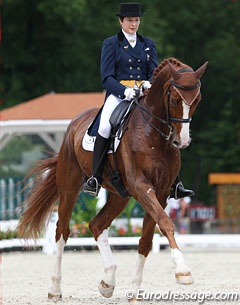
Combining the harmony of classical training with the impulsion of competitive dressage, Catherine and Michel Henriquet have spent over 40 years perfecting their method and are very familiar with the rewarding experience of training young horses.
"In the training of a young horse, the hardest part is 6-7 years because they are taught the movements and they must then keep the balance," said Henriquet. "It's also tiring physically for the rider, who needs to use their body and train with sensitivity to be properly understood."
For a young horse to stand out, Catherine says "it must have the best pulse, sensitivity, good balance and a mind that is as natural as possible. It should not ask the question, but deliver to its rider."
Dedicating their lives to the ‘La Légèreté en Equitation’ Catherine's husband Michel took up dressage over half a century ago, when he went in search of the classical training techniques passed on by the famous School of Versailles in the 18th century. After being introduced to the great Nuno Oliveira, Michel developed a life-long friendship with the classical master and still employs his methods to this day.
"Michel worked for 30 years with Master Nuno Oliveira," says Catherine. "And what he learnt from the master he has passed on to me. Through his knowledge Michel enabled me to discover the various equestrian disciplines and the different school approaches in the sport of dressage. He trained me for 10 years and as a result of his relationship with the four major classical training academies (Saumur, Vienna, Lisbon, and Jerez) I was able to get right into the heart of these wonderful establishments, and connect with many of the world's greatest champions."
The pair have been able to put this knowledge into use on their equestrian property in the French village of Autouillet and they work hard everyday, keeping their training philosophy alive and ensuring it prospers long into the future of dressage competition.
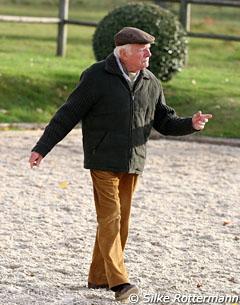 "Michel (88 years) no longer rides, but is there every morning to attend the training of our personal horses. He also stays busy as he continues to write and teach," Catherine explained. "I currently have 20 horses on the property, some through other owners, and 4 horses that I have in training for myself. I have one horse of 12 years at Grand Prix level, a 9-year old doing Inter I, and two young horses, a 5 year old and a 3 year old."
"Michel (88 years) no longer rides, but is there every morning to attend the training of our personal horses. He also stays busy as he continues to write and teach," Catherine explained. "I currently have 20 horses on the property, some through other owners, and 4 horses that I have in training for myself. I have one horse of 12 years at Grand Prix level, a 9-year old doing Inter I, and two young horses, a 5 year old and a 3 year old."
Catherine does not buy a young horse especially to achieve the movements of GP, but enjoys training each horse so it can reach its own potential.
"In general, I do not care if a young horse does not have the natural talent from the beginning. I train, and gradually introduce the difficult movements and if the horse does not fit the target once he is trained, I sell him on. However, I generally find the ratio for me is around 4 out of 5 youngsters will make it to GP level."
The first dressage rider to compete on an Iberian horse at the Olympic Games, Catherine took her Lusitano Orphée to Barcelona and can appreciate the talents of different breeds, and their ease of trainability.
"We found Orphée through a breeder friend, who reported that one of the foals he had attempted to break had resulted in total failure," she reminisced. "Michel and I went to see for the horse for ourselves, and tried our own luck at the task. In five days we were on his back and made the decision right there to buy him. At this stage I had never entered in any competition. Our goal was simply to provide the best possible training in the classical way."
By the time Orphée was 8 he was doing all the movements of Grand Prix. At that time Saumur's chief rider, Col. Christian Carde, encouraged Catherine to go out into the competition world. Just four years later that this wonderful horse participated in the Barcelona Olympics!
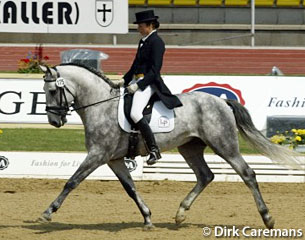 Having won the French championship title in 1991, Catherine knew Orphée was a top Lusitano and says the horse illustrates how the Iberian breeds have developed.
Having won the French championship title in 1991, Catherine knew Orphée was a top Lusitano and says the horse illustrates how the Iberian breeds have developed.
"We started with the Baroque type Lusitano horse, which are more compact, rhythmic creatures, but through the process of top breeding we have evolved and developed the Lusitano’s gaits, producing that special one that led me to Barcelona."
Irrelevant to her whether a horse is young or fully trained to GP, Catherine's passion is just educating and teaching each horse the movements, in order to achieve the highest levels of collection.
"In general, at about 8 years old a young horse will know all the movements of GP. This allows another 2 to 3 years for the horse to be able to move from one figure to another without making a mistake. And finally, yet another year for the art of presentation," she explained.
For a young horse to be truly exceptional, Catherine believes the horse must hold a range of key attributes and also have the mind to see it through.
"The flexibility of a contortionist, the voltage of an athlete, epidermal sensitivity of a Stradivarius, the total absence of fear, a franchise to accommodate the most unusual of environmental circumstances, great nobility, and the unstoppable ability to learn and understand."
When looking for a horse that may just fulfill all that, Catherine focuses on "his model, his balance, his gaits, and how he puts it all to use. "How he uses his hind legs, the way he plays with his body freedom, his character. However, there will always be those horses that don't fit the mould, and yet are still brilliant."
Through experience and after having had many failures, Catherine has learnt to tell if a horse will make it, but knows that this takes time, patience, and perseverance. Henriquet said she gradually learned to see the small details, that reveal the true qualities. Even if a horse is just two years of age, Catherine can see if it will stand out. She identify a top horse at this age through his particularly identifiable model and gaits, but she admits that the character can only be determined under one's seat.
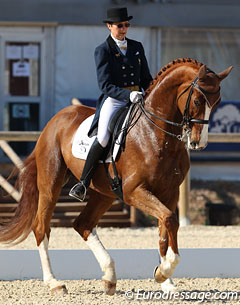 Leaving most of the training schedule up to the horse's natural balance, Catherine introduces the lateral work gradually, so it can slowly lead to the commencement of the flying changes at the beginning of 6 years. She begins with the shortening steps for the piaffe in the led up to 5 years. However the amount of time needed for each stage depends on each individual horse, some learn quickly, others because they are late, take more time. "With young horses, it's important to also incorporate a lot of outside work, often late in the session for around 20 to 30 minutes," she said.
Leaving most of the training schedule up to the horse's natural balance, Catherine introduces the lateral work gradually, so it can slowly lead to the commencement of the flying changes at the beginning of 6 years. She begins with the shortening steps for the piaffe in the led up to 5 years. However the amount of time needed for each stage depends on each individual horse, some learn quickly, others because they are late, take more time. "With young horses, it's important to also incorporate a lot of outside work, often late in the session for around 20 to 30 minutes," she said.
In terms of young horse training, Catherine and Michel focus on the seat of the rider as well as the coordination of the aids, without ever using hand and leg in opposition.
"A good rider must try to understand that a horse is not a machine ready to do the work but needs to been given proper time to learn and mature. A good rider must not rush over glass steps, as the foundations will shatter. The basics are very important!"
Catherine is inspired by riders who, through conventional methods, achieve the same results as others using forceful means.
"I see beauty in riders who can use classical methods, to produce in the horse what is often obtained today through compressive strength and the support of training aids."
Reminding us that the art of classical riding was invented in the fourteenth century with the noble Iberian horses, Catherine says classical dressage required extreme mobility, dazzling transitions, as well as absolute generosity from the horse.
"Unfortunately, today the objective is to prioritise towards modern movements which are very strong and regular; inconsistent with the purposes of the original equestrian art," she stated. "With the focus of dressage being shifted to produce results in the arena, I was curious as to how the pair define 'lightness', and whether this ideal can truly be achieved in competition. Lightness is when the horse can move by himself, in balance, more or less in collection, with the capacity to stand alone. He must not rely on the hand to compress it. This is a contact that can break at any moment, without the balance being at all disrupted or the horse falling forward."
Henriquet is not a big fan of extravagance in the show ring. "People are often impressed by a rider who can quickly produce the school airs (piaffe, passage) without seeing how it was produced, thus reflecting a lack of culture and observation," she said. "They fail to see the force behind it, whether voluntary or involuntary. A good coach must be experienced in training many different horses to have the knowledge of what to do in different circumstances. The apprentice trainer must understand what is required to gain the capacity for teaching analysis; he must allow much time to perfect his position, he must read the classics, and he must see what is happening in the different "schools" of the different countries."
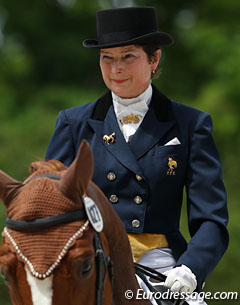 According to Michel Nuno did not believe that lightness and competition could be united, but Catherine says that it can be achieved if the rider is well trained and has the right feeling.
According to Michel Nuno did not believe that lightness and competition could be united, but Catherine says that it can be achieved if the rider is well trained and has the right feeling.
"Any rider can achieve lightness in collection if they have a good harmony in the use of their aids from the commencement of a young horse's training. They must then bring the horse up gradually to the supreme balance by conventional means, which are those of the School of Versailles (La Guérinière). A top competition rider is a lightweight rider who takes the contact with perfect feeling and a lot of fluidity. Unfortunately, however, this is not often the rider who wins."
With experience on a range of talented horses of all different breeds, Catherine knows that in order to succeed a horse must have more than just the physical talent to reach the highest level. The German and Dutch Stud farms have dramatically changed over the past 20 years, so much so that they are now able to produce horses with the qualities of the Iberian while having excellent gaits.
Catherine believes that overall we require a lot from a top horse, whatever the breed. The young horse must have everything: gaits, balance and mental capacity!
"The horse should always match as close as possible to the ideal sought by the objectives pursued," she concluded.
by Sarah Warne for Eurodressage
Photos © Astrid Appels - Silke Rottermann - Dirk Caremans
Related Link
Catherine and Michel Henriquet: Training and Competing in the Tradition of the Legerete